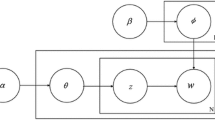Abstract
Macroeconomic conditions and users’ word of mouth have significant impacts on the purchase decisions of consumers, and they can be potentially used to conduct better sales forecasts, but study on this aspect is relatively scarce. In this paper, a novel method for forecasting product sales based on macroeconomic indicators and online reviews is developed. Firstly, an algorithm is given to select proper macroeconomic indicators to capture the long-term trends of sales. Subsequently, an algorithm for sentiment analysis is given to convert textual online reviews into numerical digits, and the word-of-mouth effect is calculated by incorporating the data related to online reviews (e.g., ratings, browsing numbers, and approval numbers). The sentiment index of word-of-mouth effect is measured based on the prospect theory, which can accurately reflect the phenomenon whereby negative reviews seriously affect the purchasing decisions of consumers. Further, according to the selected macroeconomic indicators and the obtained sentiment index, a logarithmic autoregressive model for product sales forecasting is constructed, and the model parameters are estimated by the Adam optimizer. Finally, experimental studies on forecasting the sales volume of the Audi A6L in the next three quarters are conducted. The experimental results show that the performance of the proposed method is significantly better than the existing methods.









Similar content being viewed by others
Explore related subjects
Discover the latest articles, news and stories from top researchers in related subjects.References
Archak N, Ghose A, Ipeirotis PG (2011) Deriving the pricing power of product features by mining consumer reviews. Manag Sci 57(8):1485–1509
Asur S, Huberman BA (2010) Predicting the future with social media. In: Proceedings of the international conference on web intelligence and intelligent agent technology, pp 492–499
Chase C (2015) Demand-driven forecasting: a structured approach to forecasting. Wiley, New York
Chatterjee S, Hadi AS (2006) Transformation of variables. In: Regression analysis by example. https://doi.org/10.1002/0470055464.ch6
Chen Y, Xie J (2008) Online consumer review: word-of-mouth as a new element of marketing communication mix. Manag Sci 54(3):477–491
Chong AYL, Li B, Ngai EW, Ch’ng E, Lee F (2016) Predicting online product sales via online reviews, sentiments, and promotion strategies. Int J Oper Prod Manag 36(4):358–383
Dey A, Jenamani M, Thakkar JJ (2018) Senti-n-gram: an n-gram lexicon for sentiment analysis. Expert Syst Appl 103:92–105
Duan W, Gu B, Whinston AB (2008) Do online reviews matter? An empirical investigation of panel data. Decis Support Syst 45(4):1007–1016
Fan ZP, Che YJ, Chen ZY (2017a) Product sales forecasting using online reviews and historical sales data: a method combining the Bass model and sentiment analysis. J Bus Res 74:90–100
Fan ZP, Xi Y, Li YL (2017b) Supporting the purchase decisions of consumers: a comprehensive method for selecting desirable online products. Kybernetes 47(2):689–715
Frisch R (1934) Statistical confluence analysis by means of complete regression systems. Economics Institute, University of Oslo, Oslo, Norway, pp 44–71
Gao J, Xie Y, Cui X, Yu H, Gu F (2018) Chinese automobile sales forecasting using economic indicators and typical domestic brand automobile sales data: a method based on econometric model. Adv Mech Eng 10(2):1–11
Kahneman D, Tversky A (1979) Prospect theory: an analysis of decision under risk. Econometrica 47(2):263–292
Kang H, Yoo SJ, Han D (2012) Senti-lexicon and improved Naïve Bayes algorithms for sentiment analysis of restaurant reviews. Expert Syst Appl 39(5):6000–6010
Kingma DP, Ba JL (2015) Adam: a method for stochastic optimization. In: International conference on learning representations, vol 2015, pp 1–15
Ku LW, Chen HH (2007) Mining opinions from the Web: beyond relevance retrieval. J Am Soc Inf Sci Technol 58(12):1838–1850
Kuhn M, Johnson K (2013) Applied predictive modeling. Springer, New York
Liu Y, Bi JW, Fan ZP (2017) Ranking products through online reviews: a method based on sentiment analysis technique and intuitionistic fuzzy set theory. Inf Fusion 36:149–161
Marshall P, Dockendorff M, Ibáñez S (2013) A forecasting system for movie attendance. J Bus Res 66(10):1800–1806
Racherla P, Friske W (2012) Perceived “usefulness” of online consumer reviews: an exploratory investigation across three services categories. Electron Commer Res Appl 11(6):548–559
Sagaert YR, Aghezzaf EH, Kourentzes N, Desmet B (2018) Tactical sales forecasting using a very large set of macroeconomic indicators. Eur J Oper Res 264(2):558–569
Schmidt U, Starmer C, Sugden R (2008) Third-generation prospect theory. J Risk Uncertain 36(3):203–223
Segal J, Sacopulos M, Sheets V, Thurston I, Brooks K, Puccia R (2012) Online doctor reviews: do they track surgeon volume, a proxy for quality of care? J Med Internet Res 14(2):50
Verhulst PF (1838) Notice sur la loi que la population suit dans son accroissement. Corr Math et Phys 10:113–121
Xu X, Hao J, Yu L, Deng Y (2018) Fuzzy optimal allocation model for task-resource assignment problem in collaborative logistics network. IEEE Trans Fuzzy Syst. https://doi.org/10.1109/tfuzz.2018.2826479
Ye Q, Law R, Gu B (2009) The impact of online user reviews on hotel room sales. Int J Hosp Manag 28(1):180–182
Yu X, Liu Y, Huang X, An A (2012) Mining online reviews for predicting sales performance: a case study in the movie domain. IEEE Trans Knowl Data Eng 24(4):720–734
Acknowledgements
This work was partially supported by the National Science Foundation of China (Project Nos. 71871049 and 71771043), the Fundamental Research Funds for the Central Universities, China (Project No. N170605001), and the 111 Project (B16009).
Author information
Authors and Affiliations
Corresponding author
Ethics declarations
Conflict of interest
The authors declare that they have no conflict of interest.
Ethical approval
This article does not contain any studies with human participants or animals performed by any of the authors.
Informed consent
Informed consent was obtained from all individual participants included in the study.
Additional information
Communicated by X. Li.
Publisher’s Note
Springer Nature remains neutral with regard to jurisdictional claims in published maps and institutional affiliations.
Rights and permissions
About this article
Cite this article
Zhang, C., Tian, YX., Fan, ZP. et al. Product sales forecasting using macroeconomic indicators and online reviews: a method combining prospect theory and sentiment analysis. Soft Comput 24, 6213–6226 (2020). https://doi.org/10.1007/s00500-018-03742-1
Published:
Issue Date:
DOI: https://doi.org/10.1007/s00500-018-03742-1




